Related Research Articles
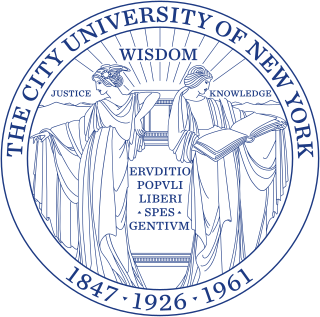
The City University of New York is the public university system of New York City. It is the largest urban university system in the United States, comprising 25 campuses: eleven senior colleges, seven community colleges, and seven professional institutions. While its constituent colleges date as far back as 1847, CUNY was established in 1961. The university enrolls more than 275,000 students and counts thirteen Nobel Prize winners and twenty-four MacArthur Fellows among its alumni.
A misdemeanor is any "lesser" criminal act in some common law legal systems. Misdemeanors are generally punished less severely than more serious felonies, but theoretically more so than administrative infractions and regulatory offences. Typically, misdemeanors are punished with monetary fines or community service.
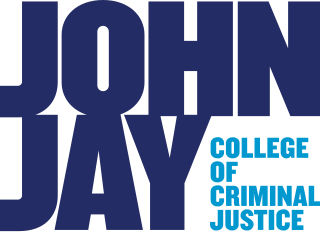
The John Jay College of Criminal Justice is a public college focused on criminal justice and located in New York City. It is a senior college of the City University of New York (CUNY). John Jay was founded as the only liberal arts college with a criminal justice and forensic focus in the United States.

The Violent Crime Control and Law Enforcement Act of 1994, commonly referred to as the 1994 Crime Bill, or the Clinton Crime Bill, is an Act of Congress dealing with crime and law enforcement; it became law in 1994. It is the largest crime bill in the history of the United States and consisted of 356 pages that provided for 100,000 new police officers, $9.7 billion in funding for prisons which were designed with significant input from experienced police officers. Sponsored by U.S. Representative Jack Brooks of Texas, the bill was passed by Congress and signed into law by President Bill Clinton. Then-Senator Joe Biden of Delaware drafted the Senate version of the legislation in cooperation with the National Association of Police Organizations, also incorporating the Assault Weapons ban and the Violence Against Women Act (VAWA) with Senator Orrin Hatch.
Furman v. Georgia, 408 U.S. 238 (1972), was a landmark criminal case in which the United States Supreme Court invalidated all then existing legal constructions for the death penalty in the United States. It was 5–4 decision, with each member of the majority writing a separate opinion. Following Furman, in order to reinstate the death penalty, states had to at least remove arbitrary and discriminatory effects in order to satisfy the Eighth Amendment to the U.S. Constitution.
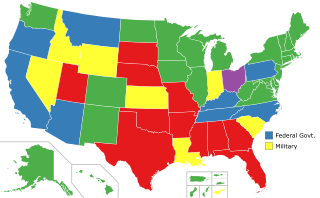
In the United States, capital punishment is a legal penalty throughout the country at the federal level, in 27 states, and in American Samoa. It is also a legal penalty for some military offenses. Capital punishment has been abolished in 23 states and in the federal capital, Washington, D.C. It is usually applied for only the most serious crimes, such as aggravated murder. Although it is a legal penalty in 27 states, 20 states have the ability to execute death sentences, with the other seven, as well as the federal government, being subject to different types of moratoriums. The existence of capital punishment in the United States can be traced to early colonial Virginia. Along with Japan, Singapore, and Taiwan, the United States is one of four advanced democracies and the only Western nation that applies the death penalty regularly. It is one of 54 countries worldwide applying it, and was the first to develop lethal injection as a method of execution, which has since been adopted by five other countries. The Philippines has since abolished executions, and Guatemala has done so for civil offenses, leaving the United States as one of four countries to still use this method. It is common practice for the condemned to be administered sedatives prior to execution, regardless of the method used.

Prison reform is the attempt to improve conditions inside prisons, improve the effectiveness of a penal system, or implement alternatives to incarceration. It also focuses on ensuring the reinstatement of those whose lives are impacted by crimes.
In the United States, the relationship between race and crime has been a topic of public controversy and scholarly debate for more than a century. Crime rates vary significantly between racial groups; a 2005 study by the American Journal of Public Health observed that the odds of perpetrating violence were 85% higher for blacks compared with whites, with Latino-perpetrated violence 10% lower. However, academic research indicates that the over-representation of some racial minorities in the criminal justice system can in part be explained by socioeconomic factors, such as poverty, exposure to poor neighborhoods, poor access to public and early education, and exposure to harmful chemicals and pollution. Racial housing segregation has also been linked to racial disparities in crime rates, as blacks have historically and to the present been prevented from moving into prosperous low-crime areas through actions of the government and private actors. Various explanations within criminology have been proposed for racial disparities in crime rates, including conflict theory, strain theory, general strain theory, social disorganization theory, macrostructural opportunity theory, social control theory, and subcultural theory.
Crime has been recorded in the United States since its founding and has fluctuated significantly over time. Crime rates have varied over time, with a sharp rise after 1900 and reaching a broad bulging peak between the 1970s and early 1990s. After 1992, crime rates have generally trended downwards each year, with the exceptions of a slight increase in property crimes in 2001 and increases in violent crimes in 2005-2006, 2014-2016 and 2020-2021. While official federal crime data beginning in 2021 has a wide margin of error due to the incomplete system adoption of the National Incident-Based Reporting System by government agencies, federal data for 2020-2021 and limited data from select U.S. cities collected by the nonpartisan Council on Criminal Justice showed significantly elevated rates of homicide and motor vehicle theft in 2020-2022. Although overall crime rates have fallen far below the peak of crime seen in the United States during the late 1980s and early 1990s, the homicide rate in the U.S. has remained high relative to other "high income"/developed nations, with eight major U.S. cities ranked among the 50 cities with the highest homicide rate in the world in 2022. The aggregate cost of crime in the United States is significant, with an estimated value of $4.9 trillion reported in 2021. Since 2022, crime has stabilized and has declined overall; though remains higher than pre-Covid-19 pandemic levels.

Race in the United States criminal justice system refers to the unique experiences and disparities in the United States in regard to the policing and prosecuting of various races. There have been different outcomes for different racial groups in convicting and sentencing felons in the United States criminal justice system. Although prior arrests and criminal history is also a factor. Experts and analysts have debated the relative importance of different factors that have led to these disparities.
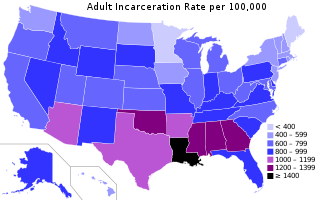
According to the latest available data at the World Prison Brief on May 7, 2023, the United States has the sixth highest incarceration rate in the world, at 531 people per 100,000. Between 2019 and 2020, the United States saw a significant drop in the total number of incarcerations. State and federal prison and local jail incarcerations dropped by 14% from 2.1 million in 2019 to 1.8 million in mid-2020. In 2018, the United States had the highest incarceration rate in the world.

In the United States, sentencing law varies by jurisdiction. The jurisdictions in the US legal system are federal, state, regional, and county. Each jurisdictional entity has governmental bodies that create common, statutory, and regulatory law, although some legal issues are handled more often at the federal level, while other issues are the domain of the states. Civil rights, immigration, interstate commerce, and constitutional issues are subject to federal jurisdiction. Issues such as domestic relations, which includes domestic violence; marriage and divorce; corporations; property; contracts; and criminal laws are generally governed by states, unless there is federal preemption.
Peter Moskos is an American professor at John Jay College of Criminal Justice in the Department of Law, Police Science, and Criminal Justice Administration and the CUNY Graduate Center in the Department of Sociology. He is a former Baltimore Police Department officer. The son of military and Greek American sociologist Charles Moskos, he specializes in policing, crime, and punishment. Moskos was listed by The Atlantic as one of their "Brave Thinkers of 2011" for his book In Defense of Flogging. In Defense of Flogging proposes giving individuals convicted of a crime a choice between incarceration and corporal punishment.

Kevin Nadal is an author, activist, comedian, and Distinguished Professor of Psychology at John Jay College of Criminal Justice and The Graduate Center of the City University of New York. He is a researcher and expert on the effects of microaggressions on racial/ethnic minorities and LGBTQ people.

The United States incarcerates more of its youth than any other country in the world through the juvenile courts and the adult criminal justice system, which reflects the larger trends in incarceration practices in the United States. In 2010, approximately 70,800 juveniles were incarcerated in youth detention facilities alone. As of 2006, approximately 500,000 youth were brought to detention centers in a given year. This data does not reflect juveniles tried as adults. As of 2013, around 40% were incarcerated in privatized, for-profit facilities.
African Americans, and African American males in particular, have an ethnic stereotype in which they are portrayed as dangerous criminals. This stereotype is associated with the fact that African Americans are proportionally over-represented in the numbers of those that are arrested and convicted for committing crimes. It has appeared frequently in American popular culture, reinforcing the negative consequences of systemic racism.

The New Jim Crow: Mass Incarceration in the Age of Colorblindness is a book by Michelle Alexander, a civil rights litigator and legal scholar. The book discusses race-related issues specific to African-American males and mass incarceration in the United States, but Alexander noted that the discrimination faced by African-American males is prevalent among other minorities and socio-economically disadvantaged populations. Alexander's central premise, from which the book derives its title, is that "mass incarceration is, metaphorically, the New Jim Crow".
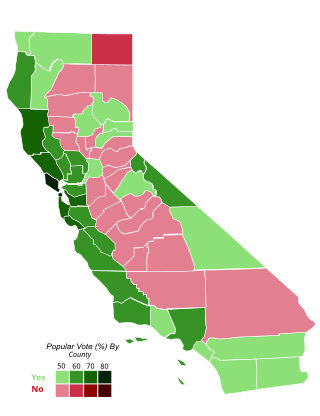
Proposition 47, also known by its ballot title Criminal Sentences. Misdemeanor Penalties. Initiative Statute, was a referendum passed by voters in the state of California on November 4, 2014. The measure was also referred to by its supporters as the Safe Neighborhoods and Schools Act. It recategorized some nonviolent offenses as misdemeanors, rather than felonies, as they had previously been categorized.

Criminal justice reform seeks to address structural issues in criminal justice systems such as racial profiling, police brutality, overcriminalization, mass incarceration, and recidivism. Reforms can take place at any point where the criminal justice system intervenes in citizens’ lives, including lawmaking, policing, sentencing and incarceration. Criminal justice reform can also address the collateral consequences of conviction, including disenfranchisement or lack of access to housing or employment, that may restrict the rights of individuals with criminal records.

Jeremy Travis is an American academic administrator who served as the fourth president of John Jay College of Criminal Justice, a senior college of the City University of New York, starting on August 16, 2004. On October 25, 2016, Travis announced that he would step down from his position as president the next year. In August 2017, he joined the Arnold Ventures LLC as Senior Vice President of Criminal Justice.
References
- 1 2 3 4 "Professor Barry Latzer's Op-ed on the Shooting in Ferguson, MO Published in the New York Post". John Jay College of Criminal Justice.
[O]p-ed ... titled 'Time to Start Deracializing Ferguson' ...; ... [h]is history of violent crime in the United States, 'Murder, Mayhem Mugging' is due out in 2015
- ↑ Frum, David (19 June 2016). "The Cultural Roots of Crime". The Atlantic.
- ↑ Willick, Jason (23 February 2016). "Backlash". The American Interest.
- ↑ Lopez, Graham (1 September 2016). "Confronting the myth that "black culture" is responsible for violent crime in America". Vox.
- ↑ Latzer, Barry (2021). The Roots of Violent Crime in America: From the Gilded Age through the Great Depression. LSU Press.
- 1 2 Latzer, Barry (2022). The Myth of Overpunishment: A Defense of the American Justice System and a Proposal to Reduce Incarceration While Protecting the Public. Republic Book Publishers.
- ↑ Mathews, Jay (6 September 2005). "Freshman Classes Getting Hooked on the Classics". The Washington Post.
- ↑ Willing, Richard (11 February 2002). "Fight against death penalty gains ground". USA Today.
- ↑ Latzer, Barry (2011). Death Penalty Cases: Leading U.S. Supreme Court Cases on Capital Punishment (3rd ed.). Newton, Mass.: Butterworth-Heinemann.
- ↑ Latzer, Barry (1991). State Constitutions and Criminal Justice. Greenwood Press.
- ↑ Latzer, Barry (1995). State Constitutional Criminal Law. Rochester, N.Y.: Clark, Boardman, Callaghan.
- ↑ "Barry Latzer, PhD Biography". ProCon.org. May 22, 2019. Archived from the original on 17 January 2021.
- ↑ Gershman, Jacob (May 13, 2004). "CUNY Campuses Measure Up to Ivy League". ACTA American Council of Trustees and Alumni.
- ↑ Mathews, Jay (May 18, 2004). "Learning the Value of Liberal Arts". ACTA American Council of Trustees and Alumni.
- ↑ "National Association of Scholars". sourcewatch.org. July 5, 2022.
- ↑ Latzer, Barry (September 3, 2022). "C-SPAN (Barry Latzer)". C-SPAN.org.
- ↑ Latzer, Barry. "Internet Archive". Archive.org. Retrieved September 3, 2022.
- ↑ Latzer, Barry (September 3, 2022). "Youtube: Barry Latzer". Youtube.
- ↑ Death Penalty Cases.
{{cite book}}:|website=ignored (help) - ↑ Stringham, Edward (30 July 2016). "Is America Facing a Police Crisis? (book review)". The Wall Street Journal. ProQuest 1807673628.